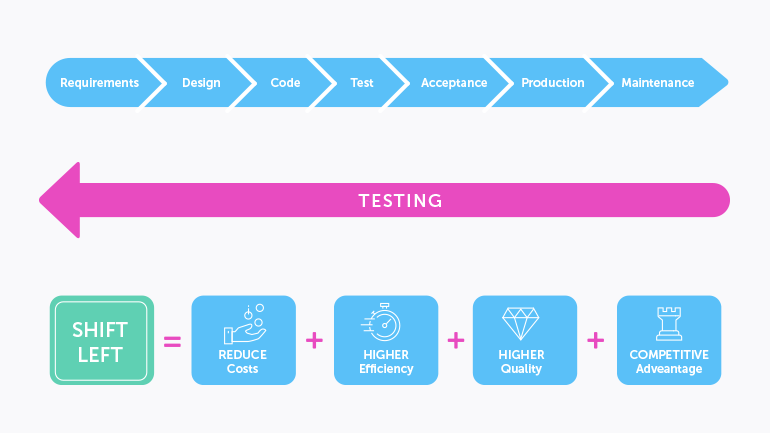By: Sofía Palamarchuk for Abstracta
If you work in the software industry, you’ve most likely heard about the popular term, “shift-left testing.” With Agile practices like TDD, BDD, CI and DevOps becoming mainstream, “shift-left” is the answer to how testing fits in, and must be done in order for them to become a reality. Instead of taking a backseat during the development process, testing is planned in advance and begins earlier in the SDLC (therefore “shifts left”). It could even start before a single line of code is written! Making this shift changes the view of testing— instead of traditional QA, it transforms into QE: Quality Engineering.
What Does Shift-Left Testing Look Like?
Thanks to the rise of automation, and the aid of tools that use AI and machine learning, testers have more time to dedicate to being more strategic about their work, instead of having their hands tied, running tests manually every day.
For testers to be successful today, they have to not only be great at testing, but also be engineers of the Agile testing process by collaborating with development and operations while analyzing quality during every stage of development:

Shift-left testing activities include:
-
- Testers helping developers implement unit testing
-
- Planning, creating, and automating integration test cases
-
- Planning, creating, and employing virtualized services at every stage and component level
-
- Gathering, prioritizing, and processing feedback
Several process changes occur when teams shift left. Instead of a developer waiting weeks to add his or her code to the rest of the team’s code, it can be done every day, or even several times a day. Instead of manually performing all the tests, most are automated and run every day, or even several times a day. And, instead of detecting problems at the end, the team as a whole analyzes quality as the development progresses.
Not sure if it’s the right move for your organization? Here are some of the pros and cons of shift left testing.
PROS
LOWER THE COST OF TESTING & DEVELOPMENT
It’s well known that the sooner a bug is found, the cheaper it is to fix. One of the aims of Agile testing is detecting errors as soon as possible. With shift-left testing it’s possible to detect in real time, the exact moment in which an error was inserted into the system in order to resolve it in a timely manner. When testing is done with each build (especially during unit testing), the errors that are found are smaller, easier to detect and locate, and subsequently, less costly to fix.
INCREASE EFFICIENCY & QUALITY
With the increased levels of automation when shifting left, teams can benefit from:
-
- Increased test coverage since more tests can be run in the same amount of time
-
- More time for testers to focus on more challenging and rewarding tasks
-
- Reduced human error rate
-
- Monitoring performance over time
-
- Code quality checks
-
- Built-in security checks
- Reducing issues in production that users may encounter
Beyond these benefits, being able to start testing sooner invariably results in a higher quality product, as testers are less rushed to find all the errors at the end, when there’s little time left to fix them.
COMPETE MORE FIERCELY
In today’s competitive technological landscape, the barriers to compete are minimal, so the best way to survive is to be able to move fast and defend one’s stature by innovating in iterations, which is possible thanks to Agile. As everyone can agree that it’s important to deliver software more quickly, it also mustn’t be rushed out the door (causing a possible backfire). Shift-left testing answers the problem of accelerating development without sacrificing quality.
Another—yet less obvious—benefit of shifting left is that it can help businesses position themselves as an attractive employer to top talent. Because it is becoming more mainstream, with about two thirds of IT workers reportedly using Agile or leaning towards agile (according to a recent study by HP), it’s what the most forward thinking software professionals expect from their teams. Therefore, if you want to be an attractive employer or at least on-par with the rest, it is important to adopt the modern practices that both testers and developers want to master in order to stay relevant in today’s labor market.
Cons
EASIER SAID THAN DONE
For shift-left testing to be a success, an often drastic change in culture must occur first, which requires a team effort. Teams are usually set in their traditional ways of working, and when they consider shifting, they must consider how the methods, processes, skills, tooling, etc. will need to change. Even more important, what will need to happen to get all the roles within the organization to align properly?
RISK OF BOTTLENECKS
Yes, agile and shift-left aim to eliminate testing as a bottleneck, but it is true that agile teams can find themselves stuck waiting in a queue once all of the pieces come together in the performance and user acceptance testing phases, due to the complexity of environments and composite applications. One way to overcome this is to to utilize service virtualization. Service virtualization emulates the behavior of essential components that will be present in production, enabling integration tests to take place much earlier in development. This is how you can eliminate that key bottleneck, while also benefiting from eliminating errors earlier on. Along with service virtualization, there are several tools to setup automated systems and CI such as Jenkins.
A Worthwhile Undertaking
In the end, shift left testing is certain to have pros that outweigh its cons. Testers will find themselves delegating some of their work to developers and assigning them more testing activities. In mature teams, the testers become “coaches,” training developers on how to write better code, avoid bugs, and own unit testing. The advantage of this is that the tester who used to be busy, bogged down by writing test cases, now has time to delve deeper into the product, working on business cases, penetration testing, performance testing, implementing smarter testing solutions that use artificial intelligence like Testim.io, and so on. This sharing of the responsibility over testing leads to a higher level of achieved quality, as more of the bases get covered, quicker!
What do you think? Still not on-board to shift left testing? Or have you managed to do so already?
About the Author: Sofía Palamarchuk

Sofía is the Chief Executive Officer and Chief Product Officer of software testing services company, Abstracta. With a B.S. in Computer Engineering, Sofía started working in application performance optimization, system monitoring and load testing for the corporate sector for many years. With a solid background in performance tuning and automation, Sofía has become a business development leader and is responsible for managing all aspects of Abstracta’s US operations as well as its mobile testing tool, Monkop.



